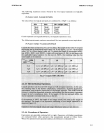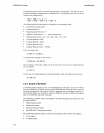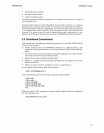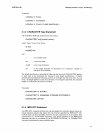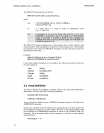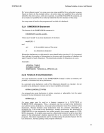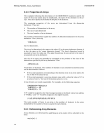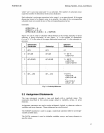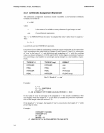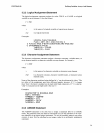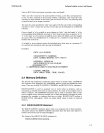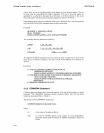
FORTRAN-80
Defining Variables, Arrays, And Memory
By
'array
element
name'
we
mean
an
array
name qualified by a subscript in paren-
theses as shown in the example above.
An
array
name
not
qualified by a sUbscript
identifies the entire array, with
one
exception. In
an
EQUIVALENCE
statement, an
array
name
not
qualified by a subscript identifies the first element
of
the array.
An
array
name
is
local
to
the
program
unit in which it
is
declared.
3.2.1 DIMENSION Statement
The
format
of
the
DIMENSION
statement is:
01
M ENSION ary(d) [,ary(d)].
..
where each
'ary(d)'
is
an
array
declarator
of
the form
ary(d
[,d]
....
)
and
ary
is
the symbolic
name
of
the
array
d
is
a dimension declarator
Dimension declarators are discussed in more detail below (section 3.2.3). In general,
they indicate the
number
of
dimensions in the
array
and
the
number
of
elements (or
upper
bound)
of
each dimension. The maximum
number
of
dimensions
is
seven.
Examples:
LOGICAL
TABLE
INTEGER ARRAY
DIMENSION TABLE(2,3), ARRAY(3,3,3)
3.2.2 Kinds of Array Declarators
An
array
declarator
('ary(d)'
in the
DIMENSION
format)
is
either a constant, ad-
justable,
or
assumed-size
array
declarator.
In a constant
array
declarator, each
of
the dimension bounds
is
a constant.
An
ad-
justable
array
declarator contains one
or
more variables as bounds:
ARRAY(3,MI00LE,THIRD)
An
assumed-size
array
declarator
is
either constant
or
adjustable,
but
the upper
bound
of
the last dimension
is
an
asterisk.
ARRA Y(3,3, *)
An
array
name
may be used as a
dummy
argument
in a
FUNCTION
or
SUBROUTINE
subprogram.
Thus,
a
program
can have actual
array
declarators
and
dummy
array
declarators.
An
actual
array
declarator must be a constant
array
declarator, whereas
dummy
array
declarators may be constant, adjustable,
or
assumed size. Like actual
array
declarators,
dummy
declarators are permitted in
DIMENSION
or
type statements, but unlike actuals, they
cannot
appear
in COM-
MON
statements. A variable
name
used as a dimension
bound
of
an
array
must also
appear
in the
subprogram's
dummy
argument
list
or
in a
common
block in the sub-
program.
The latter requirements can be avoided using the asterisk feature for the
last dimension, thereby gaining some
program
efficiency.
3-5



